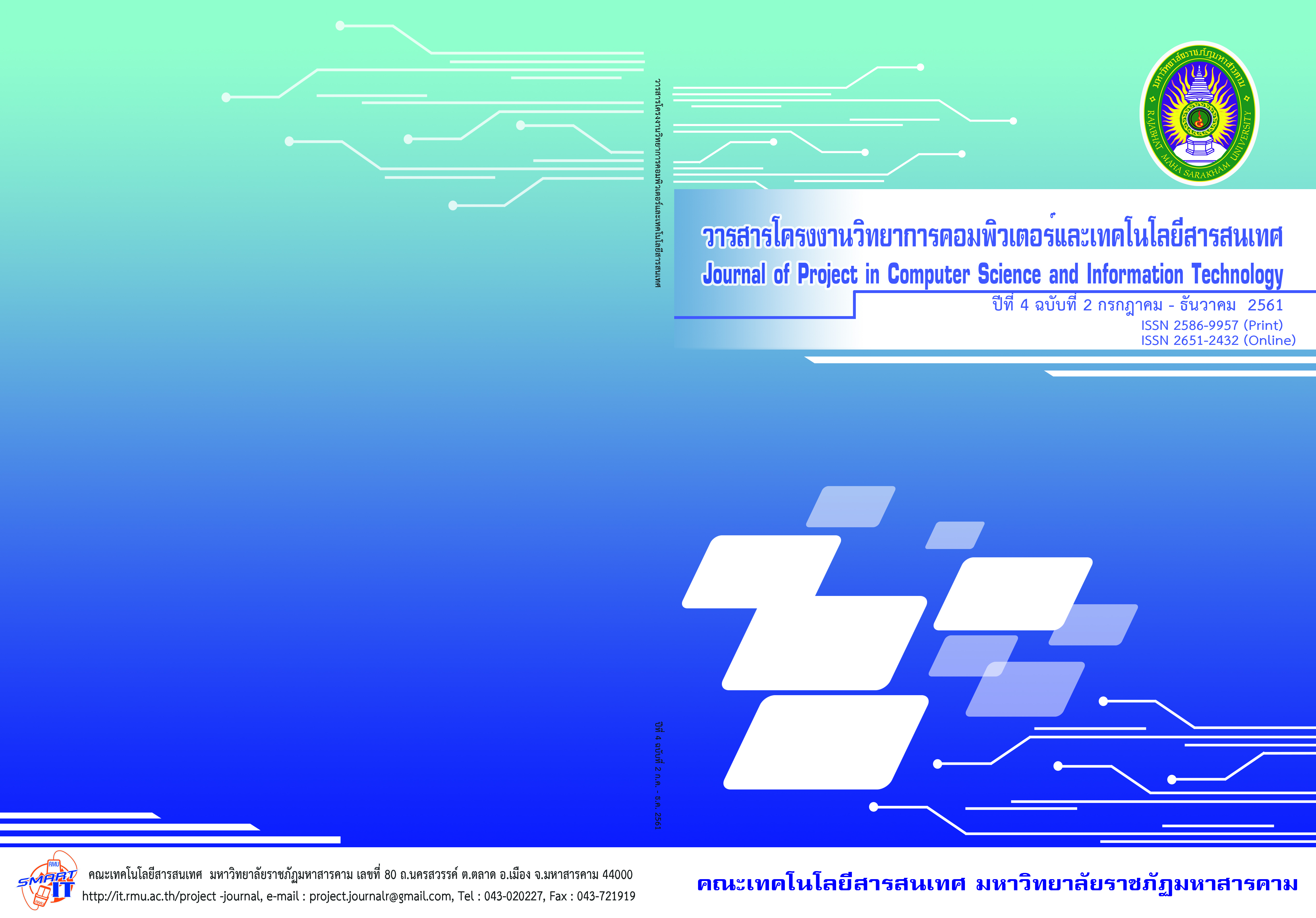เกมมิฟิเคชันเพื่อการเรียนรู้
Main Article Content
บทคัดย่อ
การศึกษาเกมมิฟิเคชันเพื่อการเรียนรู้เป็นวิธีการศึกษารูปแบบและแนวคิดของการสร้างเกมมิฟิเคชัน เป็นรูปแบบการเรียนรู้ที่ได้จากการวิเคราะห์ สังเคราะห์เอกสารและงานวิจัยที่เกี่ยวข้องเกี่ยวกับรูปแบบการเรียนรู้แบบออนไลน์และใช้ได้กับทุกสภาพแวดล้อมจากสื่อและแหล่งเรียนรู้ที่หลากหลาย เพื่อให้เกิดการเรียนรู้ได้ทุกเวลา ทุกสถานที่ โดยสามารถ
นำกลศาสตร์การเล่นเกมมาปรับใช้กับกิจกรรมการเรียนรู้ เพื่อกระตุ้นให้เกิดการมีส่วนร่วมของผู้เรียนและจัดประสบการณ์
การเรียนรู้ที่สอดคล้องกับความถนัด ดังนั้นเกมมิฟิเคชันสามารถนำไปปรับใช้กับการเรียนรู้ในยุคปัจจุบัน ที่ถูกขับเคลื่อนไปด้วยเทคโนโลยีสารสนเทศและการสื่อสารให้เป็นการเรียนการสอนที่ใช้หลักกลไกของเกม ทำให้ผู้เรียนมีความตื่นตัว
มีความกระตือรือร้นในการเรียน โดยแนวคิดเกมมิฟิเคชันสามารถประยุกต์ใช้เข้ากับการเรียนการสอนทุกระดับ
และทุกสาขาวิชา รวมทั้งสามารถบูรณาการโครงสร้างของเกมมาใช้ในการออกแบบบทเรียน ทำให้เนื้อหามีความน่าสนใจ
และส่งเสริมให้ผู้เรียนเกิดพฤติกรรมการมีส่วนร่วมกับการเรียนได้ กระบวนการเรียนรู้เกมมิฟิเคชันประกอบด้วย ความหมายของเกมมิฟิเคชัน องค์ประกอบของเกมมิฟิเคชัน กรอบแนวคิดของเกมมิฟิเคชัน ขั้นตอนการพัฒนาเกมมิฟิเคชัน ผลกระทบทางบวกและทางลบ และการนำไปประยุกต์ใช้งานในชีวิตประจำวัน ในส่วนของบทสรุปและข้อเสนอแนะที่นำไปใช้ สำหรับประเทศไทยต้องพัฒนากำลังคนให้พร้อมเข้าสู่ยุคเศรษฐกิจและสังคมดิจิทัล และเพื่อการเรียนรู้การพัฒนากำลังคนวัยทำงานทุกสาขาอาชีพ ทั้งบุคลากรภาครัฐและภาคเอกชน ให้มีความสามารถในการสร้างสรรค์และใช้เทคโนโลยีดิจิทัลอย่างชาญฉลาดในการประกอบอาชีพได้ด้วยตนเองในยุคปัจจุบันและอนาคต
Article Details
เอกสารอ้างอิง
Tie Strength. Journal of Computer-Mediated Communication, 21(2016), 265–281.
[2] Balancing-acting Africa. (2017). WORLD BANK EAST ASIA AND PACIFIC ECONOMIC UPDATE OCTOBER 2017. Washington, DC : International Bank for Reconstruction and Development , The World Bank.
[3] กฤษณพงศ์ เลิศบำรุงชัย. (2560). เกมมิฟิเคชัน (Gamification) โลกแห่งการเรียนรู้ที่ขับเคลื่อนด้วยเกม. สืบค้นจาก
http://touchpoint.in.th/gamification/
[4] McGonigal, J. (2011). Reality Is Broken: Why Games Make Us Better and How They Can Change the World. New York : Penguin Press.
[5] Deterding, S., Dixon, D., Khaled, R., & Nacke, L. (2011). From game design elements to gamefulness: defining
gamification. In Proceedings of the 15th International Academic MindTrek Conference: Envisioning Future Media Environments (MindTrek ’11): New York : ACM.
[6] Hee, Jung Park & Jae, Hwan Bae. (2014). Study and Research of Gamification Design. International Journal of Software
Engineering and Its Application, 8(8), 19-28.
[7] ใจทิพย์ ณ สงขลา. (2561). การออกแบบการเรียนแนวดิจิทัล. กรุงเทพฯ: โรงพิมพ์แห่งจุฬาลงกรณ์ มหาวิทยาลัย.
[8] ชนัตถ์ พูนเดช, และธนิตา เลิศพรกุลรัตน์. (2559). แนวทางการจัดการเรียนรู้ด้วยแนวคิดเกมมิฟิเคชัน. วารสารศึกษาศาสตร์มหาวิทยาลัย
นเรศวร, 18(3), 331-339.
[9] อัรฮาวี เจ๊ะสะแม, นันทวัน นาคอร่าม, และสำราญ ผลดี. (2560). การพัฒนาต้นแบบเกมจำลองสถานที่ท่องเที่ยวโดยการใช้รูปแบบเกมมิฟิเคชัน
กรณีศึกษาเกมปุรณาวาส ท่องเที่ยวพาเพลิน. วารสารวิชาการมหาวิทยาลัยธนบุรี (วิทยาศาสตร์และเทคโนโลยี), 1(1), 14-23.
[10] Banfield, J., and Wilkerson, B. (2014). Increasing student intrinsic motivation and self-efficacy through gamification
pedagogy. Contemporary Issues in Education Research (CIER), 7(4), 291-298.
[11] Foreman J. (2003). Next-Generation Educational Technology versus the Lecture. EDUCAUSE Review, 38(4), 12-16.
[12] Robson, K., Plangger, K., Kietzmann, J. H., McCarthy, I., and Pitt, L. (2015). Is it all a game? Understanding the principles
of gamification. Business Horizons, 58(4), 411-420.
[13] Gamification Wiki. (2015). Game Mechanics. Retrieved Dec, 01, 2015, Retrieved from https://badgeville.com/wiki/
Game_Mechanics Gamification Wiki. (2015b). Gamification Examples. Retrieved from https://badgeville.com/
wiki/Gamification_Examples
[14] Kuo, M.S., & Chuang, T.Y. (2016). How gamification motivates visits and engagement for online academic
dissemination – An empirical study. Computers in Human Behavior, 55, 16-27.
[15] Robson, K., Plangger, K., Kietzmann, J. H., McCarthy, I., & Pitt, L. (2015). Is it all a game? Understanding the principles
of gamification. Business Horizons, 58(4), 411-420.
[16] Brian, B. (2014). Gartner Redefines Gamification. Retrieved from http://blogs.gartner.com/brian_burke/2014
/04/04/gartner-redefines-gamification/.
[17] กุลชัย กุลตวนิช, และรัตตมา รัตนวงศา. (2559). การศึกษาเปรียบเทียบความคิดเห็นและทัศนคติต่อแนวคิดเกมมิฟิเคชันของนิสิตนักศึกษา
ระดับปริญญาตรี. ใน การประชุมวิชาการ ปอมท. ประจำปี 2559 และการประชุมวิชาการ “การวิจัยระบบการศึกษาไทย (CRTES)
ครั้งที่ 1. (น. 97-104). กรุงเทพฯ : สภาคณาจารย์และพนักงาน สถาบันเทคโนโ,ยีคุณทหารพระจอมเกล้าลาดกระบัง.
[18] นิตยา โชติบุตร. (2558). การพัฒนาโปรแกรมประยุกต์เกมเพื่อสร้างแรงจูงใจในการเรียนภาษาซี. (วิทยานิพนธ์ปริญญามหาบัณฑิต), มหาวิทยาลัยเทคโนโลยีสุรนารี, นครราชสีมา.
[19] ศุภกร ถิรมงคลจิต. (2558). ผลของการจัดกิจกรรมการเรียนรู้วิชาวิทยาศาสตร์ตามแนวคิดเกมิฟิเคชัน เพื่อเสริมสร้างแรงจูงใจในการเรียน ของนักเรียนชั้นประถมศึกษาปีที่ 2. (วิทยานิพนธ์ปริญญามหาบัณฑิต), จุฬาลงกรณ์มหาวิทยาลัย, กรุงเทพฯ.
[20] Dicheva, et al. (2015). Gamification in Education: A Systematic Mapping Study. Educational Technology & Society,
18(3), 75-88.
[21] Henrick, G. (2013). Gamification - What is it and What it is in Moodle. Retrieved from
http://www.slideshare.net/ghenrick/gamification-what-is-it-and-what-it-is-in-moodle
[22] Muntean, C. (2011). Raising engagement in e-learning through gamification. in 6th International Conference on Virtual
Learning ICVL, pp. 323-329.
[23] Dicheva Darina, Irwin Keith, Dichev Christo, & Talasila Swapna. (2017). Gamification in Education: A Passing Trend
or a Genuine Potential?. Proceedings of the 18th International Conference on Computer Systems and
Technologies. Ruse, Bulgaria, (pp. 1-11). New York : ACM.
[24] Domínguez et al. (2013). Gamifying learning experiences: Practical implications and outcomes. Computers & Education, 63(2013), 380-392.
[25] Perryer, C., Scott-ladd, B., & Leighton, C. (2012). Gamification: Implications for workplace intrinsic motivation in the 21.
Asian Forum on Business Education Journal, 5(3). 371-381.
[26] Simoes, J., Redondo, R. D., & Vilas, A. F. (2013). A social gamification framework for a K-6 learning platform.
Computers in Human Behavior, 29(2), 345-353.
[27] Van, der Waals, K. (2014). Gamification: Spelend Rijk. Vrij Nederland, 12(1), 44-49.
[28] Deterding, S., Dixon, D., Khaled, R., & Nacke, L. (2011). From game design elements to gamefulness: Defining
gamification. In Proceedings of the 15th International Academic MindTrek Conference: Envisioning Future Media Environments. pp. 9-15.
[29] Alexandre Peixoto de Queirós, Ricardo, Pinto, Mário Teixeira. (2017). Gamification-Based E-Learning Strategies for
Computer Programming Education. IGI Global. Information Science Reference. 701 E. Chocolate Avenue Hershey PA, USA 17033.
[30] McKay Elspeth. (2015). Macro-Level Learning through Massive Open Online Courses (MOOCs): Strategies and
Predictions for the Future. A volume in the Advances in Educational Technologies and Instructional Design
(AETID). IGI Global. Information Science Reference. 701 E. Chocolate Avenue Hershey PA, USA 17033.
[31] Ras Eric & Ana Guerrero Elena. (2017). Technology Enhanced Assessment. In 20th International Conference,
TEA 2017 Barcelona, Spain, Communications in Computer and Information Science. Springer Nature Switzerland AG.
[32] Kapp Karl M.. (2012). The gamification of learning and instruction: game-based methods and strategies for training
and education. 1st ed. San Francisco: Pfeiffer.
[33] Jackson Michael. (2016). Gamification in Education: A Literature Review. Retrieved from
https://www.usma.edu/cfe/Literature/MJackson_16.pdf
[34] Marczewski Andrzej, 2016. Marczewski’s Gamification User Types. Retrieved from
https://elearningindustry.com/marczewski-gamification-user-types
[35] Fabricatore, C., & López, X., (2014). Using Gameplay Patterns to Gamify Learning Experiences. In The European Conference on Games Based Learning. Academic Conferences & Publishing International.
[36] ประภาวรรณ ตระกูลเกษมสุข. (2559). การประยุกต์ใช้รูปแบบการเล่นวีดีโอเกมในการเรียนการสอนที่มีต่อการพัฒนาพฤติกรรม
การเข้าชั้นเรียน การมีส่วนร่วม และผลสัมฤทธิ์ทางการเรียนของนักศึกษาระดับปริญญาตรี. ใน การประชุมหาดใหญ่วิชาการระดับชาติ และนานาชาติ ครั้งที่ 7. (น. 180-192). สงขลา : มหาวิทยาลัยหาดใหญ่.
[37] จุฑามาศ มีสุข, สนิท ตีเมืองซ้าย และพงศ์ธร โพธิ์พูลศักดิ์. (2558). การจัดกิจกรรมการเรียนรู้เพื่อเสริมสร้างพฤติกรรมการมีส่วนร่วมของ
นักเรียนโดยใช้เทคนิคเกมมิฟิเคชัน สำหรับนักเรียนห้องเรียนพิเศษวิทยาศาสตร์ ชั้นมัธยมศึกษาปีที่ 4 โรงเรียนอนุกูลนารี. ใน การ
ประชุมวิชาการระดับชาติและนานาชาติ “ราชภัฏวิจัย ครั้งที่ 3”, (น. 81-90). นครศรีธรรมราช : มหาวิทยาลัยราชภัฏนครศรีธรรมราช.
[38] Kaplan University School of Information Technology. (2013). Case study: kaplan University. Retrieved from
http://badgeville.com//customer/case-study/kaplan-university
[39] Barata, G. , Gama, S. , Jorge, J. & Goncalves, D. (2013). Engaging Engineering Students with Gamification.
Retrieved from http://web.ist.utl.pt/gabriel.barata/wpcontent/papercite-data/pdf/barata2013a.pdf
[40] Iosvp, A. and Epema, D. (2014). An Experience Report on Using Gamification in Technical Higher Education.
SIGCSE’14, (pp. 3-8).
[41] Kridsanapong Lertbumroongchai and Pallop Piriyasurawong. (2017). Learning Model via Creative Problem Solving on
Cloud Computing to Enhance Creative Thinking Skills and Teamwork. in The 2nd International STEM
Education Conference. Chiang Mai, Thailand.
[42] Naomi McGrath and Leopold Bayerlein. (2013). Engaging online students through the gamification of learning materials:
The present and the future. In 30th ascilite conference 2013 Proceedings. (pp. 573-577).Macquarie University,
Sydney.
[43] จักรพันธ์ ศรียุกต์นิรันดร์. (2560). อิทธิพลเชิงสาเหตุของประเภทผู้บริโภคเป็นตัวแปรกำกับ และการขยายทฤษฎีรวมของการยอมรับ
และการใช้เทคโนโลยี 2 (UTAUT 2): กรณีศึกษาผู้ให้บริการระบบโทรศัพท์เคลื่อนที่ในประเทศไทย.
วารสารมนุษยศาสตร์และสังคมศาสตร์ มหาวิทยาลัยราชพฤกษ์, 3(2), 43-55.


